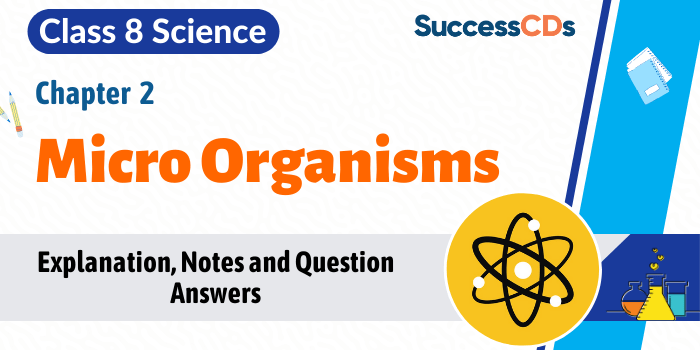
Microorganisms Class 8 Science Chapter 2 as per NCERT Book used in CBSE and other Schools. The lesson covers the complete explanation of class 8 Chapter 2 Microorganisms. Topics covered are Introduction to Micro-organisms and microbiology, different types of Micro-organisms, Useful and Harmful Micro-organisms. How to avoid the spreading of Microorganisms has been discussed. Conditions that promote Microorganisms and Preservation of Food have been explained too. The lesson covers all important questions based on microorganisms. NCERT solutions to book questions have also been provided for the convenience of the students.
Microorganisms Class 8 Video Explanation
The topics we will cover in this chapter are as follows:
- Introduction of Micro-organisms and microbiology
- Different types of Micro-organisms
- Useful and Harmful Micro-organisms
- Avoiding spreading of Micro-organisms
- Conditions that promote Micro-organisms
- Preservation of Food
There are various living organisms that exist on earth, but there are some organisms which cannot be seen with the naked eye while there are others which can be seen.
The living organisms that you fail to see with your eyes and which can be seen only with the microscope are called as micro-organisms. These microorganisms are very small and widely found. The study of microorganisms is known as microbiology
.
Most organisms are hardy and can be found in almost any kind of environment like hot deserts, polar ice caps, salt water, marsh lands and inside other organisms.
The knowledge of their existence came after the discovery of cells by Robert Hooke in 1665.
After the discovery of cells Anton van Leeuwenhoek was able to identify the first living cell in a drop of water. Anton van Leeuwenhoek discovered the microscope and microorganisms, more precisely microscopic bacteria. Later on in 1857 Louis Pasteur laid the foundation of microbiology.
Microbiology
 It is the study of microorganisms. Louis Pasteur is known as father of microbiology for his discovery of vaccines for many diseases. A vaccine is a biological preparation that provides active acquired immunity to a particular disease.
It is the study of microorganisms. Louis Pasteur is known as father of microbiology for his discovery of vaccines for many diseases. A vaccine is a biological preparation that provides active acquired immunity to a particular disease.
A vaccine typically contains an agent that is similar to a disease-causing microorganism. It is often made from weakened or killed forms of the microbe and injected into the body as per our need. Therefore, we can say that vaccines are helpful to keep us healthy and protect us from infections. Vaccines provide immunity or power inside the body, which means that it makes our body resistant to microorganisms or any infection.
Now the question arises where do these microorganisms live?
Answer: Microorganisms have flexible adaptability, that means they can survive in almost all areas or environments. They can survive under all types of environmental conditions ranging from ice cold to hot springs and deserts to marshy lands. These microorganisms are also found inside the human bodies. Some microorganisms grow on other organisms, some of them exist freely, some of them live alone, and some microorganisms live in colonies, which means that microorganisms live with similar communities. They are also found inside the bodies of animals including humans, air, water, soil, food and other things.
Question: Can microorganisms be seen with the naked eye? If not, how can they be seen?
Answer: Microorganisms are too small. So, they cannot be seen with the naked eye. To see the microorganisms like bacteria and protozoa, we use a microscope. Fungus that grows on the bread can be seen with a magnifying glass.
Types of Microorganisms
There are of five types of microorganisms, as follows-
- Bacteria
- Viruses
- Algae
- Protozoa
- Fungi
Let us discuss them in detail-
Bacteria
- These are rod-like in shape and also known as rod shaped bacteria or bacilli.

- They are unicellular microorganisms. They are mostly single- celled tiny organisms, but they live together in colonies of millions. Bacteria is to be seen under microscope which enlarges their size from a hundred to thousand times.
- They do not have well defined nucleus. It contains ribosomes and plasmids. This plasmid is helpful in reproduction.
- The size of bacteria ranges from 0.2 micron to 100 microns.
- Smallest bacteria has a size of 0.15 micron.
- Largest bacteria is 1.5 micron in size.
- Some bacterias are aerobic, which means they respire in the presence of oxygen and some of them are anaerobic, which means that they does not respire in the presence of oxygen.
- They are divided into four types depending upon shapes:
Cocci: This means that bacteria is circular or spherical in shape.
Bacillus: This means that bacteria is rod-shaped.
Spirilum: This means that bacteria is in spiral shape.
Vibrio: This means that bacteria is in comma like shape.
Viruses

- Virus cannot be seen with simple microscope.
Though, it is a microorganism, and we know that microorganisms can be seen with a simple microscope, but virus cannot be seen under a microscope. - To see them, a powerful microscope is needed.
- Viruses are the smallest of all microorganisms.
- They consist of nucleic acid covered with protein shell.
- Some viruses are living and some are non living. They are considered living when present inside living cell, but it is also considered as non living when present outside living organisms.
- They can cause many diseases. Like, AIDS is a fatal disease and caused by HIV (Human Immunodeficiency Virus).
- They appear to be likeplants, but they do not have leaves, roots, etc.
- They are simple non green plants and cannot make their food by photosynthesis.
- They are heterotrophic in nature, which means they depend on other animals for their nutritional requirement.
- They are usually parasites, which means that they live either inside or on the body of another organism and eat their food.
- They may be unicellular, which means that they have single cell.
- Examples of Viruses are: Poliovirus and Tobacco mosaic virus (Tobacco mosaic is a disease in plant).
Fungi
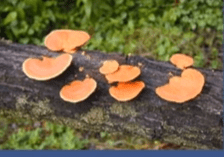
- They appear to be plants, but they do not have leaves, roots, etc. Like mushroom is an edible fruit and does not have leaves or roots.
- They are simple non green plants.
- They are heterotrophic, which means they are dependant on another animal for their food.
- Usually they are parasites.
- They may be unicellular.
- Example: Bread mould, Aspergillums, mushroom.
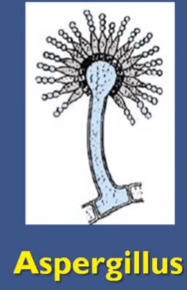
Protozoa
-
- They are unicellular in nature, which means that their body is made up of single cell.
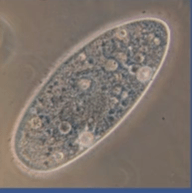
- They are mostly found in aquatic bodies.
- They are solitary or colonial, which means that they can either exist alone or live in colonies.
- They can be free living or parasitic, which means that they can live alone or are also present inside the body of other organisms.
- They are unicellular in nature, which means that their body is made up of single cell.
- Their body shape may be irregular, oval, spherical, etc.
- For example: Amoeba, Paramecium.
Algae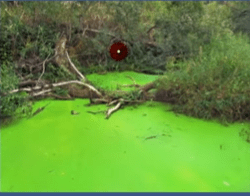
Algae is a simple, non-flowering, and typically aquatic plant of a large assemblage that includes seaweeds and many single-celled forms. Algae is green in color and also contains chlorophyll but lacks true stems, roots, leaves, and vascular tissue. Examples of Algae: Chlamydomonas, Spirogyra.
Useful Microorganisms
Useful Bacteria
- Most bacteria act as decomposers (which means that they feed on dead and decaying organic matter) and release nutrients into soil, air etc.
- Nitrogen fixing bacteria help in nitrogen fixation that helps in maintaining fertility of soil.
Like leguminous plants, roots of these plants have nodules that contains rhizobium and that bacteria has power to fix nitrogen. Thus, it helps in maintain the fertility of soil. - Bacteria help in treating sewage and producing biogas from waste.
- Many herbivores have cellulose digesting bacteria in their stomach.
- Some bacterias are helpful in the manufacturing of antibiotics like penicillin.
As we know that sometimes we do have infections like cough, sneezing, etc.; at that time, doctor prescribes us antibiotics that help to get rid of particular disease.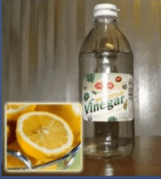
- Some bacterias are helpful in the manufacturing of products like vinegar, ethanol, etc.
- Bacterias are used in tanning of leather, etc.
- Some bacteria are used in research tools, etc.
- Some bacteria promote curd formation. Curd contains a bacterium called Lactobacillus.
Lactobacillus is a friendly-bacterium. It treats & prevents diarrhea, helps in food breakdown and absorption of nutrients.
- They are used in baking industry for making breads, pastries, cakes etc. Yeast is used as a raising agent in baking.
Most commonly used yeast is Saccharomyces cerevisiae. It is in to the action of yeast that the dough rises, if we leave it for sometime adding yeast to it during kneading.
Question: Name the microorganisms which can fix nitrogen in the soil ?
Answer: Nitrogen is needed by the plants for their growth. They cannot absorb nitrogen directly from the air. There are microorganisms like some bacteria and blue green algae in the soil that take nitrogen from the air and make nitrogenous compounds. Thus, they enrich the soil with nitrogenous compounds and make it fertile. These bacteria and blue green algae are called biological nitrogen fixer nitrogenous compounds and make it fertile. These bacteria and blue green algae are called biological nitrogen fixers.
Question: What are antibiotics? What precautions must be taken while taking antibiotics? 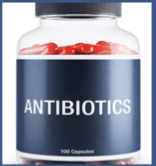
Answer: Antibiotics are the medicines (drugs) that kill or stop the growth of disease causing microorganisms in our body. Thus, they help in curing the disease. They are produced from bacteria and fungi. Penicillin, Streptomycin, Tetracycline and Erythromycin are some antibiotics. While taking antibiotics following precautions must be taken –
- Antibiotics should be taken only on the advice of a qualified doctor.
- The course prescribed by the doctor should be finished in proper doses.
- Antibiotics should not be taken unnecessarily as they may kill the beneficial bacteria in the body.
Question: Write a note on viruses.
Answer: Viruses are microorganisms and they do not have a cellular structure. They reproduce only inside the cells of other organisms. Viruses cause many diseases like common cold, flu, polio and chicken pox. Antibiotics do not kill viruses.
Question: What is vaccination? How does it help in protecting children from diseases?
Answer: The process of introducing weakened disease causing microorganisms in the body is called vaccination. The body kills the weakened microorganisms by producing antibodies. These antibodies remain in the body and kill the microorganisms if they enter again. In this way vaccination helps in protecting the children from diseases.
Useful Fungi
- They act as decomposers that help in adding nutrients to soil.
- It is used in making antibiotics.

- Yeast is also used in making alcoholic beverages and bread, idli, etc.
Yeast is commonly called as ‘khameer’. Idli/ dosa batter contain urad pulses. These urad seeds contain Lactic Acid Bacteria (LAB) and this bacteria lead to the formation of Lactic acid and Carbon dioxide. Formation of Lactic acid gives a sour taste to the batter. Therefore, the batter should not be fermented for too long, else it might turn too sour. - Mushrooms are edible fungi.
- Some of them are also used in research work.
Useful Algae
- Algae is green in color and can make food by the process of photosynthesis. Thus, it helps in supplying food to aquatic animals and also produces oxygen gas that can be used for respiration.
- Red algae is edible in certain countries.
- Algae is used in making Toothpaste, jelly etc.
- Some algae enrich the soil with nitrogen like blue green algae.
- Some algae are sources of iodine and potash like brown algae.
Harmful Microorganisms
Microorganisms are harmful as they cause many diseases. There are many microbes which cause several diseases in plants, animals & human beings. Such disease-causing organisms are called Pathogens. We can also say that pathogens are diseases causing microorganisms. Pathogens include bacteria, viruses, fungi & protozoa.
Types of diseases
There are two types of diseases which are written as below:
- Communicable
- Non Communicable
Communicable Disease
The diseases that can spread through sick to healthy person are called communicable diseases. We can also say that the communicable diseases are those diseases which can be transferred from one person to another person. For example: Flu, cold, AIDS.
Non Communicable Disease
The diseases that do not spread through sick to healthy person are called non – communicable diseases. We can also say that the communicable diseases are those diseases which cannot be transferred from one person to another person. For example: Lung Cancer or liver damage.

Question: How do pathogens enter our body?
Answer: Pathogens enter our body through the air while breathing or through water that we drink or through the food that we eat or by direct contact with an infected person or may be carried through any carrier (any source that contains pathogens).
Question: How do pathogens cause diseases?
Answer: Pathogens enter our body through any source and multiply inside the body cell and can result in disease. For example: When any person suffering from cold sneezes, some of the droplets of moisture carrying many viruses are spread in air. The same air is inhaled by another person sitting close by or in front of the infected person. So there is a chance that virus can transmit to his body and cause infection. To prevent ourselves from this kind of infection, we need to use a handkerchief and keep it on the nose and mouth while the infected person is coughing and sneezing.
Question: What are carriers and how do they spread diseases?
Answer: Carriers are the organisms that carry the pathogens to the healthy person. For example: Malaria is caused by protozoa plasmodium (causative agent) which is transmitted to healthy person by biting of female anopheles mosquitoes. Plasmodium is present in the saliva of female mosquito. Then these pathogens splits in our body and cause various diseases.
Example of other carriers: Aedes mosquito is a carrier of dengue.
Rabied dog is a carrier of rabies. The person who has hydrophobia often suffers from rabies.
To prevent mosquitoes from entering our surroundings, we need to keep our surrounding cleans and we should not let the water collect anywhere. As mosquitoes breed in water and if they will not find water they will be unable to breed.
Common human diseases caused by microorganisms (Harmful Microorganisms)
| Human Disease | Causative Microorganism | Mode of Transmission | Preventive Measures |
| Tuberculosis
Measles |
It is caused by Bacteria
It is caused by Virus |
Air
Air |
Keep the patient in complete isolation |
| Chicken Pox
Polio |
It is caused by Virus.
It is caused by Virus |
Air/Contact
Air/Water |
Keep the person belongings of the patient away from those of the other. Vaccination to be given at suitable age. |
| Cholera | It is caused by Bacteria | Water/Food | We should maintain personal hygiene and good sanitary habits. |
| Typhoid | It is caused by Bacteria. | Water | In this case, we should consume properly good food and boiled drinking water vaccination. |
| Hepatitis A | It is caused by Virus | Water | Drink boiled drinking water.
We should receive vaccination |
| Malaria | It is caused by Protozoa | Mosquito | Use mosquito net and repellents. |
Common plant diseases Caused by microorganisms (Harmful Microorganisms)
| Plant Diseases | Microorganism | Mode of transmission |
| Citrus canker | It is caused by Bacteria. | Air |
| Rust of wheat | It is caused by Fungi. | Air Seeds |
| Yellow vine mosaic of bhindi (Okra) | It is caused by Virus. | Insect |
Now the question arises, how to Avoid Spreading of Microorganisms?
Answer:
- We should wash our hands before eating, after preparing food and after using toilet.
- We should cover our mouth while coughing or sneezing.
- We Keep away from other people that are suffering from any disease.
- We should not eat food which is not fresh or not cooked properly.
Question: What are the conditions that promote growth of microorganisms?
Answer: The following conditions promote the growth of microorganisms-
- Food having high moisture content and prone to microorganisms.
- Food kept for long time at room temperature.
- When skin of fruit and vegetables is damaged. This damaged skin is more prone to microorganisms or can even spoil it.
- The food with low salt content, low sugar or acid content is more prone to microorganism.
Food preservation
Methods of preserving food at home
The following are the methods of preserving food at home-
- Dehydration
- Freezing
- Increasing temperature
- Using preservatives
Dehydration
Dehydration means removing water or moisture from food.
This stops microorganisms from growing as they cannot grow without water. It can be called sun drying. For example: Ginger, Potato chips, Fenugreek (Methi) are dehydrated and stored in houses.
Lowering temperature
We can also keep the microorganisms away from food by using low temperature. Low temperature slows down the activity of microorganisms.
For this, we make use of refrigerators for preserving food items. Food can be kept in refrigerator at about 5˚C which delays its spoilage. For example: Cooked Dal can be preserved by this method.
Increasing temperature
We can also keep the microorganism away from food by using high temperature. By increasing temperature enzymes and microorganisms are destroyed.
It involves two methods:
- Pasteurization
- Sterilization
Pasteurization
It is a process of heating food item to high temperature and then quickly cooling it. As microorganism cannot withstand change in temperature therefore, they get destroyed. This is a process in which milk is heated to about 70 degree Celsius for about 15 to 30 seconds and then suddenly chilled and stored. This process was discovered by Louis Pasteur.
Sterilization
In this process food items are exposed to high temperature for longer period of time. In some cases high pressure also used to destroy micro -organisms.
Like if we take water and boils at very high temperature it cannot withstand with that high temperature and may lead to destruction of microorganism. Or we can say that water is microorganism free.
Using Preservatives
Preservative is any substance that is added to food to keep it for long time. For example: Salt, Sugar, Acid, lemon.
Natural Preservatives
- Salt
- Sugar
- Lemon juice
- Oil spices
Chemical preservation
- Potassium meta-bisulphate
- Citric acid
- Sodium Benzoate
Time to check your knowledge by answering the following questions-
Choose the correct answer from the given options-
1. What is spyrogyra ?
I. An algae
II. A fungi
III. A protozoa
IV. A bacteria
2. Who discovered the vaccine for small pox ?
I. Louis Pasteur
II. Alexander Fleming
III. Edward Jenner
IV. John Mendal
3. What is the amount of nitrogen in the atmosphere?
I. 58%
II. 68%
III. 78%
IV. 88%
4. Mushroom is a
I. Algae
II. Virus
III. Fungi
IV. None of these
5. Amoeba is a
I. Algae
II. Fungi
III. Protozoa
IV. Virus
6. What is the name of scientist who discovered fermentation?
I. Alexander Fleming
II. Louis Pasteur
III. John Mendal
IV. Edward Jenner
7. What is the use of rhizobium bacteria?
I. Help in digestion
II. Help in nitrogen fixation
III. Cause diseases
IV. All of the above
8. What is the causative agent of malaria ?
I. Protozoa
II. Virus
III. Algae
IV. Bacteria
9. Penicillium is a
I. Algae
II. Fungus
III. Bacteria
IV. Yeast
10. Microorganisms are
I. Unicellular
II. Multi-cellular
III. Both
IV. None of these
Answers
1) II
2) III
3) III
4) III
5) III
6) II
7) II
8) I
9) II
10) II
Question: Explain the role of mosquitoes in spreading diseases. How can we control them?
Answer: Mosquitoes act as carriers of many disease causing microorganisms. Anopheles mosquito carries the parasite of malaria. Female Aedes mosquito carries the dengue virus from an infected person to a healthy person. The spread of diseases can be controlled by killing the mosquitoes. The breeding places of mosquitoes like water in the coolers, tyres, flowerpots, etc. should be drained out. Mosquito nets should be used at night.
Question: What is food poisoning? What is its effect?
Answer: Microorganisms like bacteria and fungi grow in the food and produce poisonous (toxic) substances in the food. This is called food poisoning. If such food is eaten, it may cause serious illness or even death.
Question: How is food preserved from the attack of microorganisms?
Answer: Food is preserved from the attack of microorganisms by the following methods:
1. Chemical Method: Food preservatives like Sodium Benzoate are added to pickles, jams and squashes to prevent the growth of microorganisms.
2. Preservation by Common Salt: Meat and fish are preserved by covering with dry salt. Salting is also used to preserve amla, raw mangoes and pickles.
3. Preservation by Sugar: Jams, Jellies and squashes are preserved by sugar. Sweet pickles like murabba are also preserved by using sugar. Sugar prevents the growth of microorganisms.
4. Preservation by Oil and Vinegar: Oil and vinegar are used to prevent growth of microorganisms in pickles. Mustard oil is popularly used for the preservation of pickles.
5. Heat and Cold Treatment: Milk is boiled to kill the bacteria. After it cools down it is stored in a refrigerator. Low temperature also slows down the growth of bacteria.
Question: What is fermentation? How is it useful?
Answer: The process of production of alcohol from sugar by use of yeast is called fermentation. It is useful in production of wine, baking of bread, making idlis and dosas.
Question: Write ten lines on the usefulness of microorganisms in our lives?
Answer: Microorganisms are so small that we cannot see them with the naked eye. Still they are very useful for us.
1. Lactobacillus is used to form curd from milk.
2.Rhizobium bacteria present in the roots of pulse plants fixes nitrogen from the air and supplies nitrogen compounds to the pulse plants.
3. The antibiotic Penicillin is prepared from the fungus Penicillium. This antibiotic is used to cure many diseases.
4. Some bacteria and blue green algae in the soil take nitrogen from the air and make nitrogenous compounds. Thus, they make the soil fertile.
5. Bacteria present in the soil decompose the organic matter and release the nutrients in the soil making it fertile. These nutrients are absorbed by plants.
6. Yeast is used for the production of alcohol and wine.
7. Yeast is also used for making bread, pastries and cakes.
8. Yeast is also used in making of idlis and bhaturas.
9. Bacteria present in our intestines help in proper digestion and release vitamin B. This vitamin is absorbed by our intestine.
10. Many vaccines are prepared from microorganisms. These vaccines are given to children to protect them from diseases like tuberculosis, polio.
Question: Write a short paragraph on the harms caused by microorganisms.
Answer: Microorganisms are harmful in the following ways :
- Microorganisms cause diseases like typhoid, cholera and tuberculosis in human beings.
- Microorganisms also cause plant diseases like rust of wheat and citrus canker.
- Microorganisms like bacteria and fungi cause food poisoning by producing toxic substances in the food.
- Microorganisms like bacteria and fungi cause spoilage of the food, paper, leather goods and clothes.
- Microorganisms like bacteria and protozoa cause pollution of water and make it unfit for drinking.